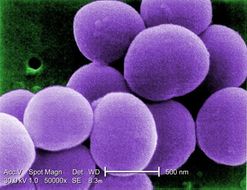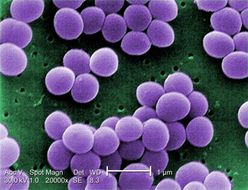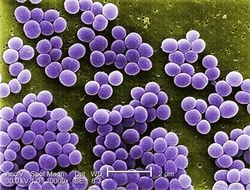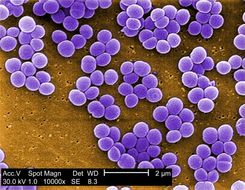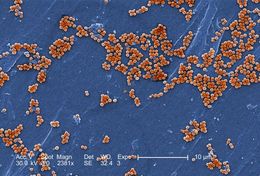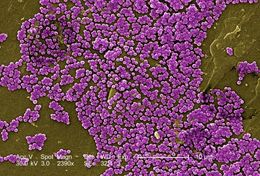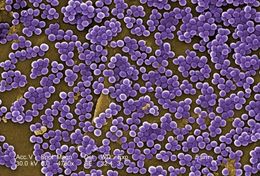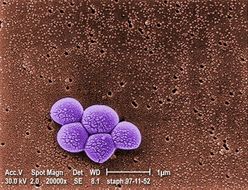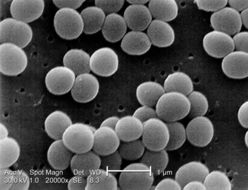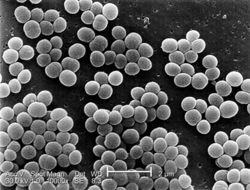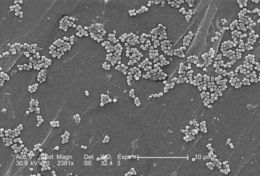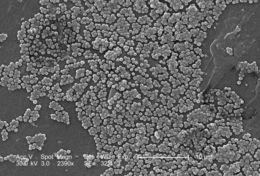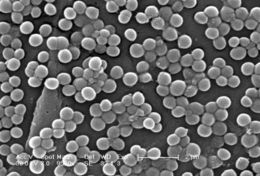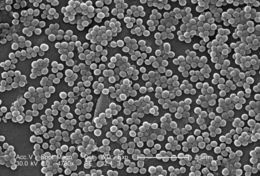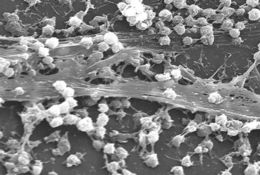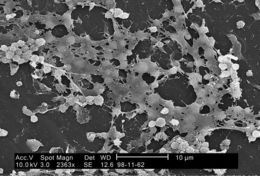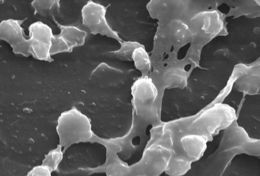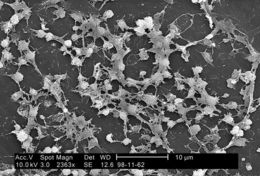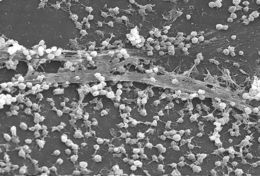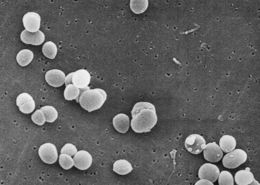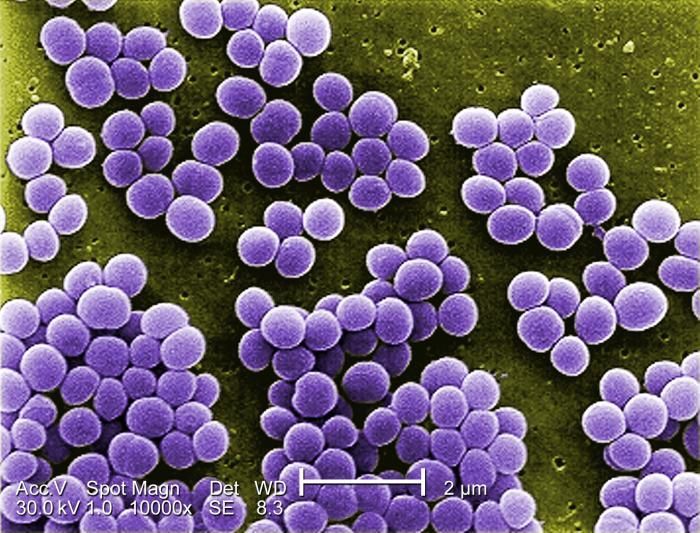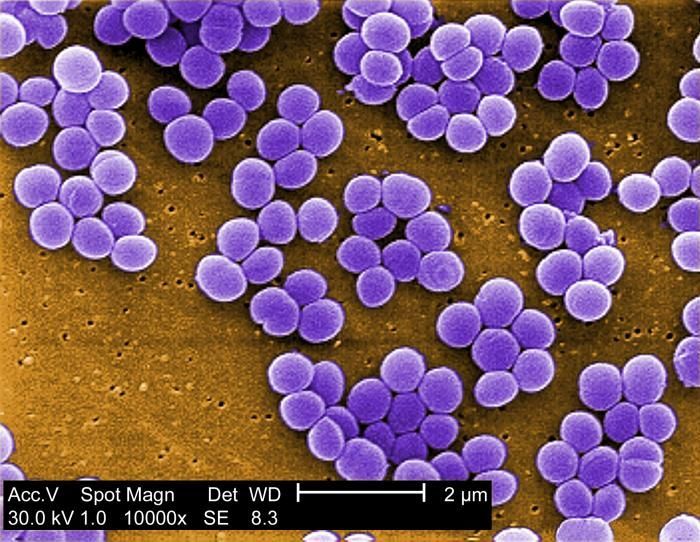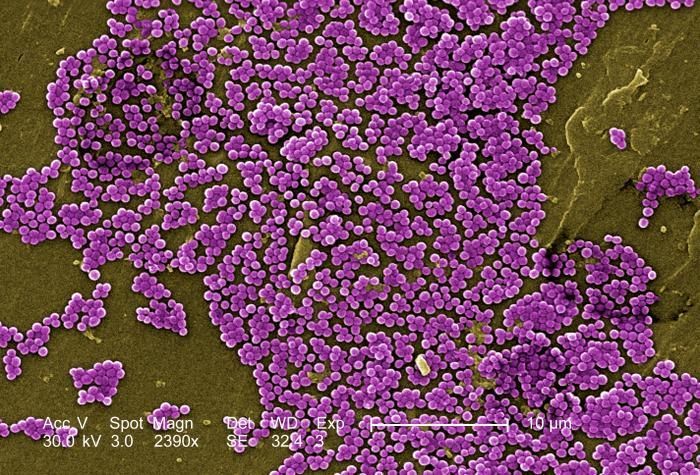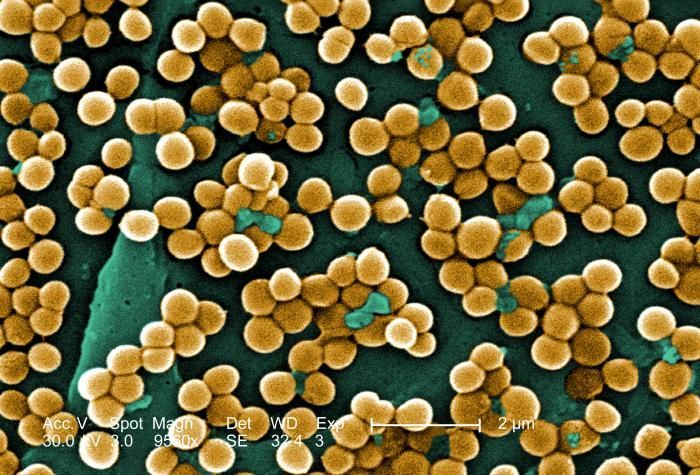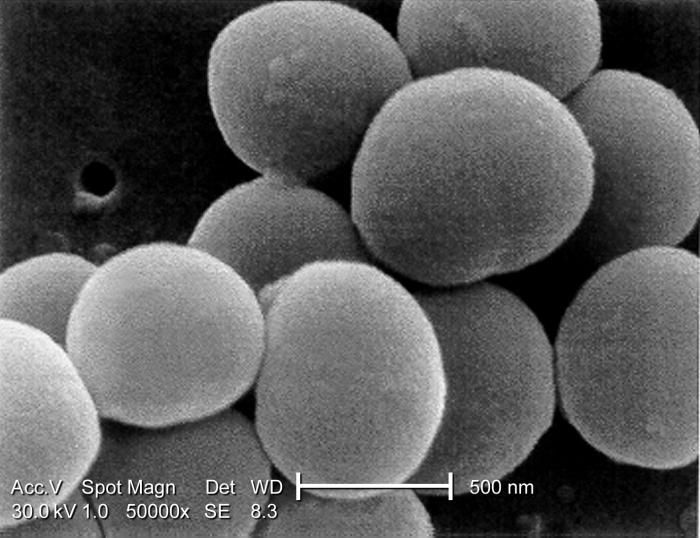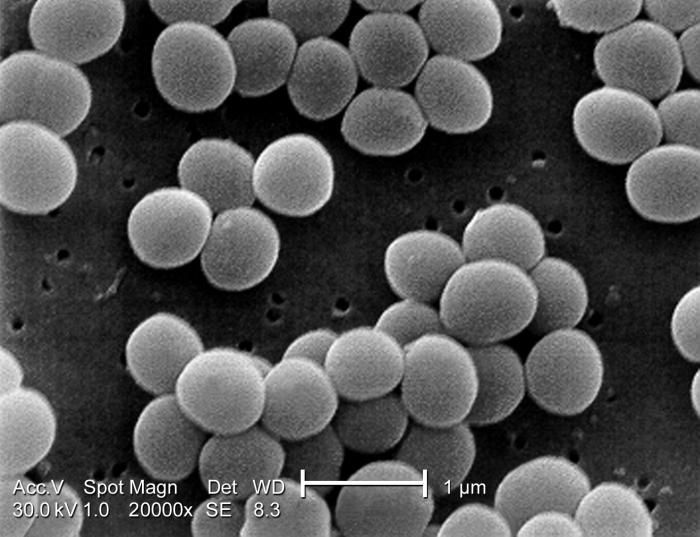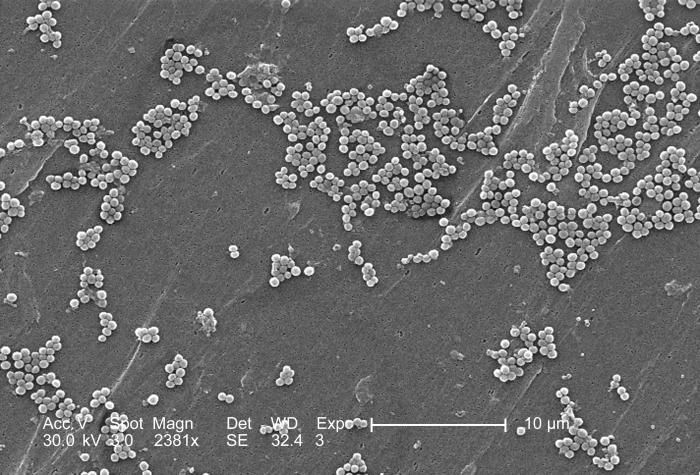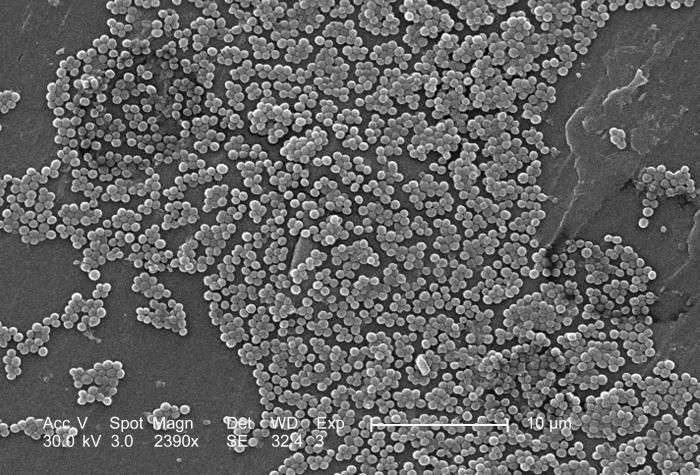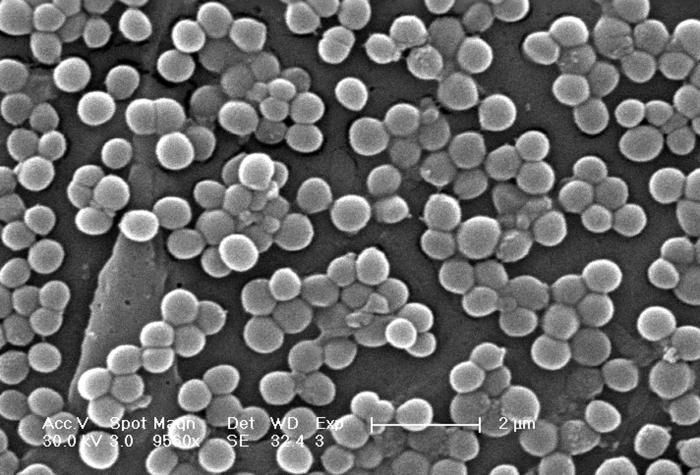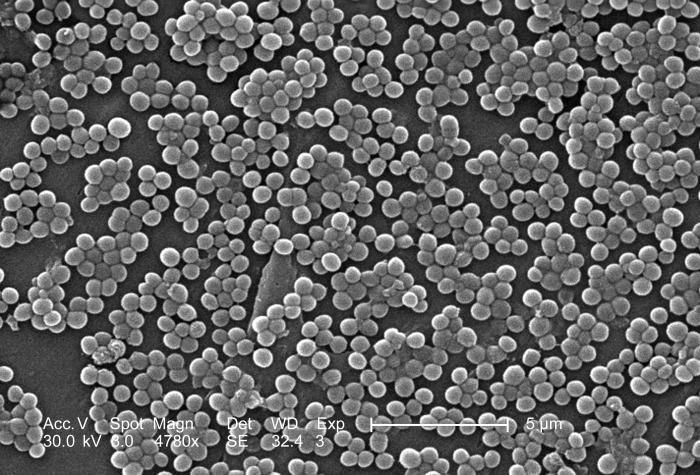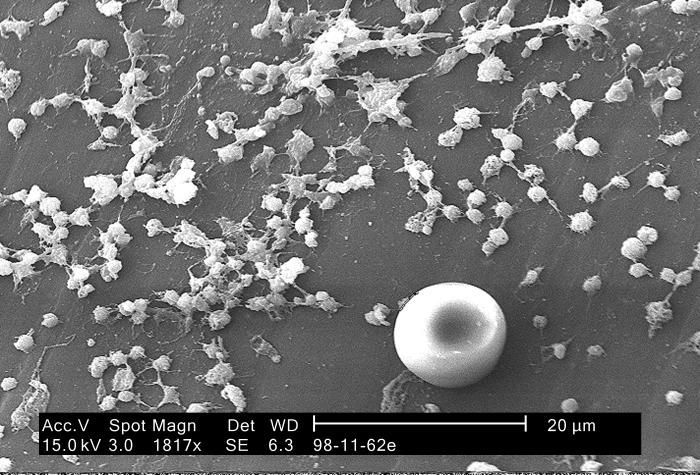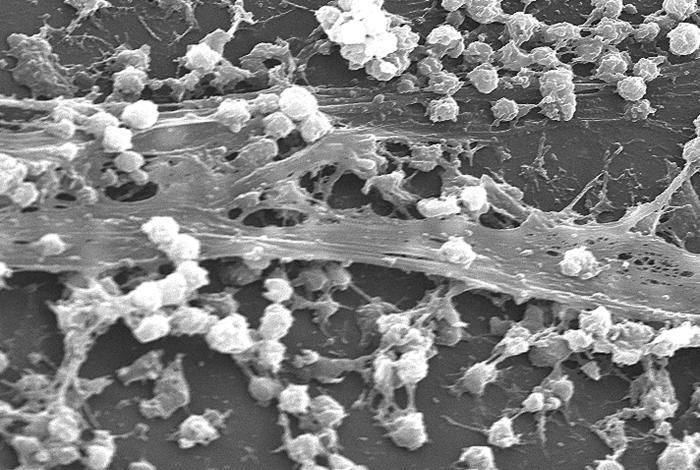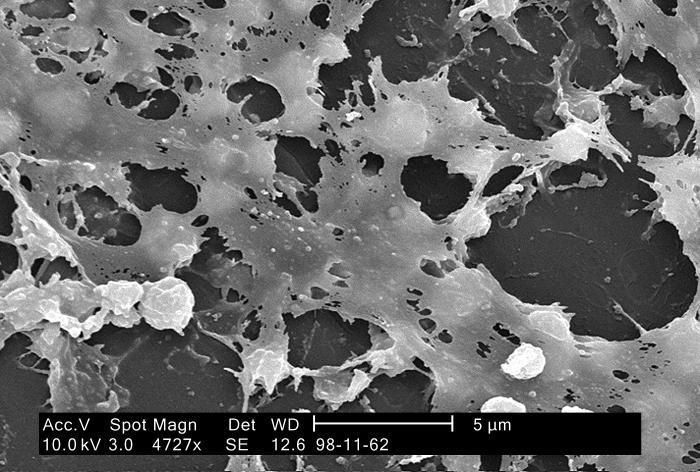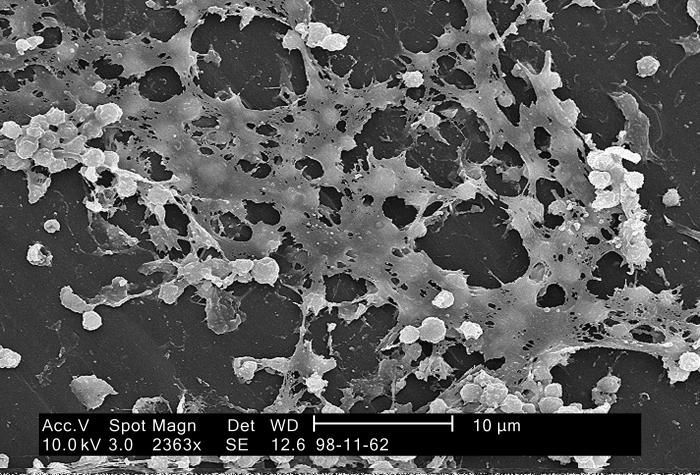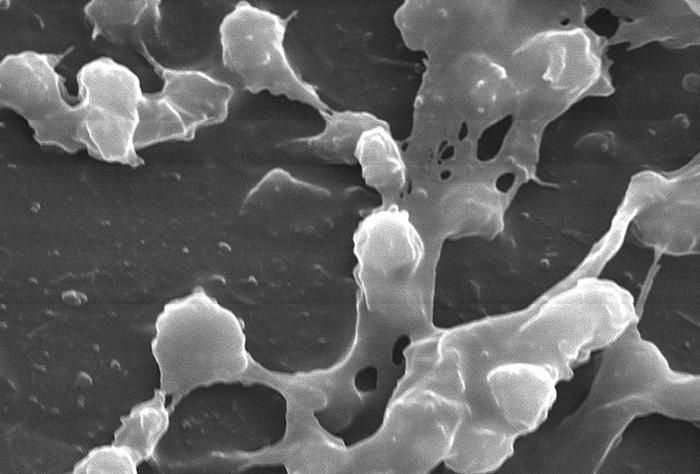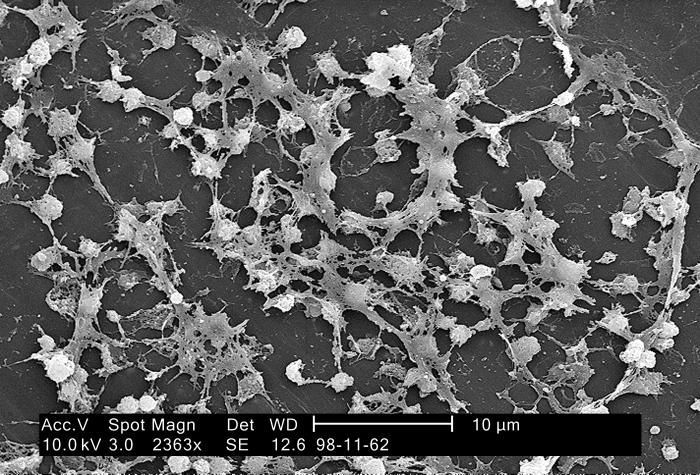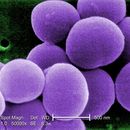-
Under a very high magnification of 50,000x, this scanning electron micrograph (SEM) shows a strain of Staphylococcus aureus bacteria taken from a vancomycin intermediate resistant culture (VISA).Under SEM, one can not tell the difference between bacteria that are susceptible, or multidrug resistant, but with transmission electron microscopy (TEM), VISA isolates exhibit a thickening in the cell wall that may attribute to their reduced susceptibility to vancomycin . See PHIL 11158 for a black and white version of this image. VISA and VRSA are specific types of antimicrobial-resistant staph bacteria. While most staph bacteria are susceptible to the antimicrobial agent vancomycin some have developed resistance. VISA and VRSA cannot be successfully treated with vancomycin because these organisms are no longer susceptibile to vancomycin. However, to date, all VISA and VRSA isolates have been susceptible to other Food and Drug Administration (FDA) approved drugs.Created: 2001
-
Under a very high magnification of 20,000x, this scanning electron micrograph (SEM) shows a strain of Staphylococcus aureus bacteria taken from a vancomycin intermediate resistant culture (VISA).Under SEM, one can not tell the difference between bacteria that are susceptible, or multidrug resistant, but with transmission electron microscopy (TEM), VISA isolates exhibit a thickening in the cell wall that may attribute to their reduced susceptibility to vancomycin . See PHIL 11156 for a black and white version of this image. VISA and VRSA are specific types of antimicrobial-resistant staph bacteria. While most staph bacteria are susceptible to the antimicrobial agent vancomycin some have developed resistance. VISA and VRSA cannot be successfully treated with vancomycin because these organisms are no longer susceptibile to vancomycin. However, to date, all VISA and VRSA isolates have been susceptible to other Food and Drug Administration (FDA) approved drugs.Created: 2001
-
Under a high magnification of 10,000x, this scanning electron micrograph (SEM) shows a strain of Staphylococcus aureus bacteria taken from a vancomycin intermediate resistant culture (VISA).Under SEM, one can not tell the difference between bacteria that are susceptible, or multidrug resistant, but with transmission electron microscopy (TEM), at least with VISA isolates one can see a thickening in the cell wall that may attribute to their reduced susceptibility to vancomycin . See PHIL 11154 for a black and white version of this image.Created: 2001
-
Under a high magnification of 10,000x, this scanning electron micrograph (SEM) shows a strain of Staphylococcus aureus bacteria taken from a vancomycin intermediate resistant culture (VISA).Under SEM, one can not tell the difference between bacteria that are susceptible, or multidrug resistant, but with transmission electron microscopy (TEM), at least with VISA isolates one can see a thickening in the cell wall that may attribute to their reduced susceptibility to vancomycin . See PHIL 6486 for a black and white version of this image.Created: 2001
-
This 2005 scanning electron micrograph (SEM) depicted numerous clumps of methicillin-resistant Staphylococcus aureus bacteria, commonly referred to by the acronym, MRSA; Magnified 2381x. Recently recognized outbreaks, or clusters of MRSA in community settings have been associated with strains that have some unique microbiologic and genetic properties, compared with the traditional hospital-based MRSA strains, which suggests some biologic properties, e.g., virulence factors like toxins, may allow the community strains to spread more easily, or cause more skin disease. A common strain named USA300-0114 has caused many such outbreaks in the United States. See PHIL 7823 for a black and white version of this micrograph.Created: 2005
-
This colorized 2005 scanning electron micrograph (SEM) depicted numerous clumps of methicillin-resistant Staphylococcus aureus bacteria, commonly referred to by the acronym, MRSA; Magnified 2390x. Recently recognized outbreaks, or clusters of MRSA in community settings have been associated with strains that have some unique microbiologic and genetic properties, compared with the traditional hospital-based MRSA strains, which suggests some biologic properties, e.g., virulence factors like toxins, may allow the community strains to spread more easily, or cause more skin disease. A common strain named USA300-0114 has caused many such outbreaks in the United States. Please see PHIL 7822 for a black and white version of this image.Created: 2005
-
This 2005 scanning electron micrograph (SEM) depicted numerous clumps of methicillin-resistant Staphylococcus aureus bacteria, commonly referred to by the acronym, MRSA; Magnified 9560x.Recently recognized outbreaks, or clusters of MRSA in community settings have been associated with strains that have some unique microbiologic and genetic properties, compared with the traditional hospital-based MRSA strains, which suggests some biologic properties, e.g., virulence factors like toxins, may allow the community strains to spread more easily, or cause more skin disease. A common strain named USA300-0114 has caused many such outbreaks in the United States. See PHIL 7821 for a black and white version of this micrograph.Created: 2005
-
This 2005 colorized scanning electron micrograph (SEM) depicted numerous clumps of methicillin-resistant Staphylococcus aureus bacteria, commonly referred to by the acronym, MRSA; Magnified 4780. Recently recognized outbreaks, or clusters of MRSA in community settings have been associated with strains that have some unique microbiologic and genetic properties, compared with the traditional hospital-based MRSA strains, which suggests some biologic properties, e.g., virulence factors like toxins, may allow the community strains to spread more easily, or cause more skin disease. A common strain named USA300-0114 has caused many such of outbreaks in the United States. See PHIL 7820 for a black and white version of this image.Created: 2005
-
Magnified 20,000X, this colorized scanning electron micrograph (SEM) depicts a grouping of methicillin resistant Staphylococcus aureus (MRSA) bacteria. See PHIL 617 for a black and white view of this image.Created: 1998
-
Under a very high magnification of 50,000x, this scanning electron micrograph (SEM) shows a strain of Staphylococcus aureus bacteria taken from a vancomycin intermediate resistant culture (VISA).Under SEM, one can not tell the difference between bacteria that are susceptible, or multidrug resistant, but with transmission electron microscopy (TEM), at least with VISA isolates one can see a thickening in the cell wall that may attribute to their reduced susceptibility to vancomycin . See PHIL 11159 for a colorized version of this image. VISA and VRSA are specific types of antimicrobial-resistant staph bacteria. While most staph bacteria are susceptible to the antimicrobial agent vancomycin some have developed resistance. VISA and VRSA cannot be successfully treated with vancomycin because these organisms are no longer susceptibile to vancomycin. However, to date, all VISA and VRSA isolates have been susceptible to other Food and Drug Administration (FDA) approved drugs.Created: 2001
-
Under a very high magnification of 20,000x, this scanning electron micrograph (SEM) shows a strain of Staphylococcus aureus bacteria taken from a vancomycin intermediate resistant culture (VISA).Under SEM, one can not tell the difference between bacteria that are susceptible, or multidrug resistant, but with transmission electron microscopy (TEM), at least with VISA isolates one can see a thickening in the cell wall that may attribute to their reduced susceptibility to vancomycin . See PHIL 11157 for a colorized version of this image. VISA and VRSA are specific types of antimicrobial-resistant staph bacteria. While most staph bacteria are susceptible to the antimicrobial agent vancomycin some have developed resistance. VISA and VRSA cannot be successfully treated with vancomycin because these organisms are no longer susceptibile to vancomycin. However, to date, all VISA and VRSA isolates have been susceptible to other Food and Drug Administration (FDA) approved drugs.Created: 2001
-
Under a high magnification of 10,000x, this scanning electron micrograph (SEM) shows a strain of Staphylococcus aureus bacteria taken from a vancomycin intermediate resistant culture (VISA).Under SEM, one can not tell the difference between bacteria that are susceptible, or multidrug resistant, but with transmission electron microscopy (TEM), at least with VISA isolates one can see a thickening in the cell wall that may attribute to their reduced susceptibility to vancomycin . See PHIL 11155 for a colorized version of this image.Created: 2001
-
This 2005 scanning electron micrograph (SEM) depicted numerous clumps of methicillin-resistant Staphylococcus aureus bacteria, commonly referred to by the acronym, MRSA; Magnified 2381x. Recently recognized outbreaks, or clusters of MRSA in community settings have been associated with strains that have some unique microbiologic and genetic properties, compared with the traditional hospital-based MRSA strains, which suggests some biologic properties, e.g., virulence factors like toxins, may allow the community strains to spread more easily, or cause more skin disease. A common strain named USA300-0114 has caused many such outbreaks in the United States. See PHIL 10048 for a colorized version of this micrograph.Created: 2005
-
This 2005 scanning electron micrograph (SEM) depicted numerous clumps of methicillin-resistant Staphylococcus aureus bacteria, commonly referred to by the acronym, MRSA; Magnified 2390x. Recently recognized outbreaks, or clusters of MRSA in community settings have been associated with strains that have some unique microbiologic and genetic properties, compared with the traditional hospital-based MRSA strains, which suggests some biologic properties, e.g., virulence factors like toxins, may allow the community strains to spread more easily, or cause more skin disease. A common strain named USA300-0114 has caused many such outbreaks in the United States. Please see PHIL 10047 for a colorized version of this image.Created: 2005
-
This 2005 scanning electron micrograph (SEM) depicted numerous clumps of methicillin-resistant Staphylococcus aureus bacteria, commonly referred to by the acronym, MRSA; Magnified 9560x.Recently recognized outbreaks, or clusters of MRSA in community settings have been associated with strains that have some unique microbiologic and genetic properties, compared with the traditional hospital-based MRSA strains, which suggests some biologic properties, e.g., virulence factors like toxins, may allow the community strains to spread more easily, or cause more skin disease. A common strain named USA300-0114 has caused many such outbreaks in the United States. See PHIL 10046 for a colorized version of this micrograph.Created: 2005
-
This 2005 colorized scanning electron micrograph (SEM) depicted numerous clumps of methicillin-resistant Staphylococcus aureus bacteria, commonly referred to by the acronym, MRSA; Magnified 4780. Recently recognized outbreaks, or clusters of MRSA in community settings have been associated with strains that have some unique microbiologic and genetic properties, compared with the traditional hospital-based MRSA strains, which suggests some biologic properties, e.g., virulence factors like toxins, may allow the community strains to spread more easily, or cause more skin disease. A common strain named USA300-0114 has caused many such of outbreaks in the United States. See PHIL 10045 for a colorized version of this image.Created:
-
This electron micrograph depicted numbers of Staphylococcus aureus bacteria, which were fond on the luminal surface of an indwelling catheter. A red blood cell (RBD), also known as an erythrocyte is present with its biconcave cytomorphology. Of importance is the sticky-looking substance woven between the round cocci bacteria, which was composed of polysaccharides, and is known as biofilm. This biofilm has been found to protect the bacteria that secrete the substance from attacks by antimicrobial agents such as antibiotics; Magnified 2363x.S. aureus, often referred to simply as "staph," are bacteria commonly carried on the skin, or in the nose of healthy people. Approximately 25% to 30% of the population is colonized, i.e., when bacteria are present, but not causing an infection, in the nose with staph bacteria.Created:
-
This electron micrograph depicted large numbers of Staphylococcus aureus bacteria, which were fond on the luminal surface of an indwelling catheter. Of importance is the sticky-looking substance woven between the round cocci bacteria, which was composed of polysaccharides, and is known as biofilm. This biofilm has been found to protect the bacteria that secrete the substance from attacks by antimicrobial agents such as antibiotics; Magnified 2363x.S. aureus, often referred to simply as "staph," are bacteria commonly carried on the skin, or in the nose of healthy people. Approximately 25% to 30% of the population is colonized, i.e., when bacteria are present, but not causing an infection, in the nose with staph bacteria.Created: 2005
-
This highly magnified electron micrograph depicted numbers of Staphylococcus aureus bacteria, which were fond on the luminal surface of an indwelling catheter. Of importance is the sticky-looking substance woven between the round cocci bacteria, which was composed of polysaccharides, and is known as biofilm. This biofilm has been found to protect the bacteria that secrete the substance from attacks by antimicrobial agents such as antibiotics; Magnified 2363x.S. aureus, often referred to simply as "staph," are bacteria commonly carried on the skin, or in the nose of healthy people. Approximately 25% to 30% of the population is colonized, i.e., when bacteria are present, but not causing an infection, in the nose with staph bacteria.Created: 2005
-
This highly magnified electron micrograph depicted numbers of Staphylococcus aureus bacteria, which were fond on the luminal surface of an indwelling catheter. Of importance is the sticky-looking substance woven between the round cocci bacteria, which was composed of polysaccharides, and is known as biofilm. This biofilm has been found to protect the bacteria that secrete the substance from attacks by antimicrobial agents such as antibiotics; Magnified 2363x.S. aureus, often referred to simply as "staph," are bacteria commonly carried on the skin, or in the nose of healthy people. Approximately 25% to 30% of the population is colonized, i.e., when bacteria are present, but not causing an infection, in the nose with staph bacteria.Created: 2005
-
This highly magnified electron micrograph depicted numbers of Staphylococcus aureus bacteria, which were fond on the luminal surface of an indwelling catheter. Of importance is the sticky-looking substance woven between the round cocci bacteria, which was composed of polysaccharides, and is known as biofilm. This biofilm has been found to protect the bacteria that secrete the substance from attacks by antimicrobial agents such as antibiotics; Magnified 2363x.S. aureus, often referred to simply as "staph," are bacteria commonly carried on the skin, or in the nose of healthy people. Approximately 25% to 30% of the population is colonized, i.e., when bacteria are present, but not causing an infection, in the nose with staph bacteria.Created: 2005
-
This electron micrograph depicted large numbers of Staphylococcus aureus bacteria, which were fond on the luminal surface of an indwelling catheter. Of importance is the sticky-looking substance woven between the round cocci bacteria, which was composed of polysaccharides, and is known as biofilm. This biofilm has been found to protect the bacteria that secrete the substance from attacks by antimicrobial agents such as antibiotics; Magnified 2363x.S. aureus, often referred to simply as "staph," are bacteria commonly carried on the skin, or in the nose of healthy people. Approximately 25% to 30% of the population is colonized, i.e., when bacteria are present, but not causing an infection, in the nose with staph bacteria.Created: 2005
-
This electron micrograph depicted the biofilm formation found inside the lumen of an indwelling catheter being secreted by Staphylococcus aureus bacteria. The biofilm secretions are primarily composed of polysaccharides, and by covering the bacteria, render the bacteria resistant to attacks they may face from antimicrobial agents. S. aureus, often referred to simply as "staph," are bacteria commonly carried on the skin, or in the nose of healthy people. Approximately 25% to 30% of the population is colonized, i.e., when bacteria are present, but not causing an infection, in the nose with staph bacteria.Created: 2005
-
This is a scanning electron micrograph depicting Gram-positive Staphylococcus aureus bacteria.Created: 2003

